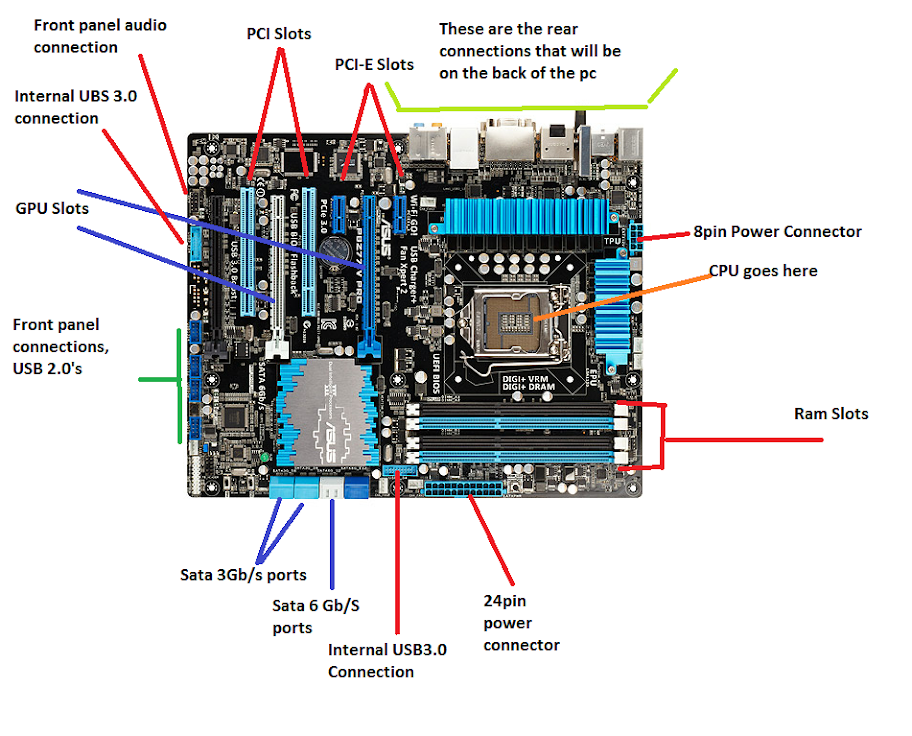A video card slot is the spot inside a computer that is specifically designed to hold a video card. There are three common types of video card slots available: peripheral component interconnect (PCI); accelerated graphics port (AGP); and peripheral component interconnect express (PCI-E). In order for a video card to fit inside the computer, the video card slot and video card need to be of the same type. This slot connects directly to the northbridge section of the computer’s chipset, allowing fast communication between the graphics card and the rest of the computer.
Inside a computer, there are several expansion slots on a motherboard. These slots allow new hardware to interface with preexisting hardware, increasing the capabilities of the computer. Most motherboards have a single slot in the highest position on the board that is specifically for a video card. Unlike the other slots, where you can plug a card into any compatible slot, this one is for video cards only.
Every desktop PC motherboard has a number of PCIe slots you can use to add GPUs (aka video cards aka graphics cards), RAID cards, Wi-Fi cards or SSD (solid-state drive) add-on cards.
Aug 23, 2018 The more DIMM slots your motherboard has, the more RAM you can install. Your motherboard may have anywhere from one to eight DIMM slots, but most mainstream motherboards have four. Princeton's WordNet (0.00 / 0 votes)Rate this definition: slot, expansion slot (noun) (computer) a socket in a microcomputer that will accept a plug-in circuit board 'the PC had three slots for additional memory'. (computer) a socket in a microcomputer that will accept a plug-in circuit board. A slot machine that is used for gambling Familiarity information: SLOT used as a noun is common. SLOT (verb) The verb SLOT has 1 sense: 1. Assign a time slot Familiarity information: SLOT used as a verb is very rare.
/pci-express-pcie-2625962-79f643e7768d4b8e81e2eee6cf5b02e7.png)
There have been several different video card slot types over the years. On a modern computer there are only three common types, from least to most common they are PCI, AGP and PCI-E slots. Older computers have other kinds, such as industry standard architecture (ISA) or video electronics standards association (VESA), but these types are nearly unheard of today.

The PCI interface was the standard video card slot type until the mid-90s. While it is nearly gone today, this slot type may still be found on some older office computers and on very low budget parts. Even though it is rarely used for video cards, this slot design is still the standard for many types of expansion cards, such as sound or network cards. As a result, PCI slots are still on most modern motherboards, they are just not used for video cards.
AGP video card slots took over from PCI as the most common style. They were on nearly every computer from the mid-90s until the mid-00s. AGP cards slots commonly have multipliers associated with them, such as x2, x4 or x8, that indicate the speed of the port. In order to utilize the slot to its fullest, it needs an AGP card with the same multiplier.
The most common style of video card slot today is PCI-E. This slot type took over from AGP in the mid-00s as the default type. While APG cards are far from gone, PCI-E has taken over the market in the late-00s. These slots are very fast, which allows for more powerful video cards.
Stands for 'Peripheral Component Interconnect.' PCI is a hardware bus used for adding internal components to a desktop computer. For example, a PCI card can be inserted into a PCI slot on a motherboard, providing additional I/O ports on the back of a computer.

The PCI architecture, also known as 'conventional PCI,' was designed by Intel and introduced in 1992. Many desktop PCs from the early 1990s to the mid 2000s had room for two to five PCI cards. Each card required an open slot on the motherboard and a removable panel on the back of the system unit. Adding PCI cards was an easy way to upgrade a computer, since you could add a better video card, faster wired or wireless networking, or add new ports, like USB 2.0.
The original 32-bit, 33 MHz PCI standard supported data transfer rates of 133 megabytes per second. An upgraded 64-bit, 66 MHz standard was created a few years later and allowed for much faster data transfer rates up to 533 MHz. In 1998, IBM, HP, and Compaq introduced PCI-X (or 'PCI eXtended'), which was backwards compatible with PCI. The 133 MHz PCI-X interface supported data transfer rates up to 1064 MHz.
Ram Slots Definition Computers
Both PCI and PCI-X were superseded by PCI Express, which was introduced in 2004.
Slots Definition Computer
Updated: June 25, 2018